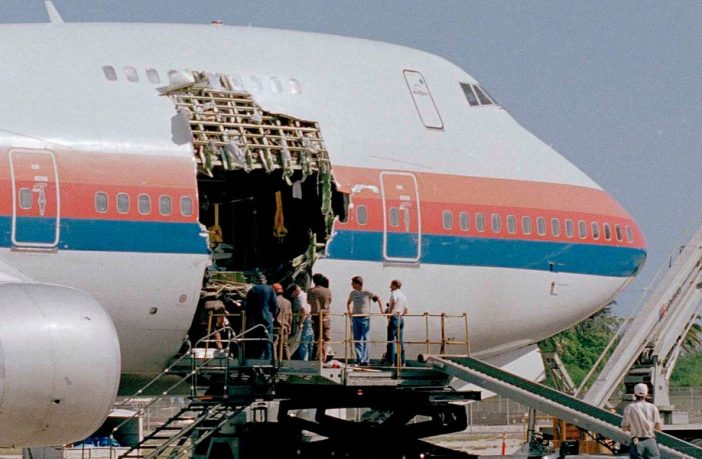
- A door stopper exploded on the side of an Alaska Airlines flight mid-flight on Friday. No one was killed.
- The last time a door exploded mid-flight on a US flight was on United Airlines Flight 811.
- Nine passengers were torn from the plane when the fuselage tore apart.
It was like an airplane passenger’s worst nightmare.
A door jam blew off an Alaska Airlines plane in mid-flight this weekend, forcing the plane to turn around and land.
The cabin was damaged but no one was seriously injured.
But nine passengers weren’t so lucky the last time a plane door shattered on a U.S. flight, more than three decades ago.
In the early morning hours of February 24, 1989, Flight 811 was traveling from Honolulu, Hawaii, to Sydney, Australia, with a stopover in Auckland, New Zealand.
While the Boeing 747-122 was still climbing from Honolulu, it was suddenly shaken by a loud noise between 22,000 and 23,000 feet in the air, according to the Federal Aviation Administration.
Seconds later, a cargo door at the front of the plane tore off, taking with it a huge portion of the plane’s fuselage and leaving a gaping hole in the cabin and cargo area, according to the FAA.
Nine passengers in that section of the plane were carried into the night sky, the AP reported; at least one of them was sucked into an engine.
“I was trying to go to sleep when I heard a whistling sound,” passenger Gary M. Garber told the New York Times at the time. “It lasted about three or four seconds and I looked at my wife next to me. All of a sudden it exploded, and I would say three or four rows of people on the right side of the plane went been destroyed.”
“There was about 18 inches between me and the open air,” he said.
“There was a huge bang, the plane crashed,” passenger Suellyn Caudwell told the Rotorua Daily Post decades later in 2018. “I could see the moon reflected in the water, I “I realized I was looking through a gaping hole in the side of the plane.”
The explosion knocked down lead flight attendant Laura Brentlinger, who clung to the spiral metal staircase inside the Boeing 747-122, CBS News reported.
“I was hanging on the bars and my feet were literally coming off the ground, hanging in the air,” Brentlinger said. Brentlinger and the other flight attendants returned safely and worked quickly to protect the other passengers on the flight.
“I remember yelling to my flight partner, ‘We’re supposed to exude confidence,’” she told CBS News. “How can I exude confidence when I’m scared to death?”
The pilots were able to turn around and make an emergency landing in Honolulu at a much higher speed than normal, according to the FAA.
“When we started to see the lights of Honolulu I knew everything was going to be OK, so we were in a controlled descent,” Caudwell told the Rotorua Daily Post. “I got up and ran as fast as anyone could run and when I looked back I couldn’t believe the size of the hole in the plane – it could have been fit through three cars.”
As federal investigators probed the disaster, the parents of one of the passengers wanted answers. Kevin and Susan Campbell launched an investigation into the explosion, reviewing photos and thousands of pages of technical documents, The Seattle Times reported.
A Boeing engineer later told a hearing that Boeing was aware of flaws in the design of the door’s locking mechanism years earlier, according to the Times.
Although Boeing warned airlines to reinforce their doors with additional pieces of aluminum, United found no defects in their doors and did not initially make repairs, the Times reported.
“Robert Doll, United’s vice president of engineering, said at the hearing that United did not believe the locks posed enough of a danger to justify the cost of quickly repairing its entire fleet,” a reported the Times.
The NTSB ultimately determined that faulty wiring and an electrical short caused the door to open, but also found that the design of the door mechanism was flawed and that Boeing, the airlines and the Federal Aviation Administration had not acted quickly enough to resolve the problem. .
“The manufacturer, the airline and the FAA had several opportunities to take actions during the life of the Boeing 747 that would have prevented this accident,” the NTSB reported.
WATCH NOW: Popular videos from Insider Inc.
Loading…
Gn tech




